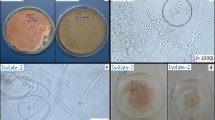Abstract
The growth abilities of fifteen fungal strains isolated fromcontaminated areas, in the presence of xenobiotics compounds mixture (overworked cuttingfluid, crude and waste oil) were examined. Strains with the richest growth were chosen for anthracene, phenanthrene and pentachlorophenol biodegradation in Sabouraudmedium (with initial xenobiotic concentration 250 mg/l in cultures with polycyclicaromatic hydrocarbons and 10 mg/l for the chlorinated substrate). Strains IM 1063and IM 6325 were able to attack phenanthrene forming its derivative 9-phenanthrenolwith the yields 5.22 mg/l and 2.82 mg/l, respectively. Strain IM 1063 and IM 6325 transformed pentachlorophenol to an intermediatecompound – pentachloromethoxybenzene. Final content of pentachloromethoxybenzene reached 3.46 mg/l and3.2 mg/l, respectively. Strain IM 6203 (contrary to other strains) released an intermediateproduct of pentachlorophenol metabolism – 2,3,5,6-tetrachlorohydroquinone(8.73 mg/l substrate remaining and 1.2 mg/l 2,3,5,6-tetrachlorohydroquinone forming).The IM 6203 strain was identified as Mucor ramosissimus. The chlorinatedpesticide degradation by M. ramossimus was improved significantly on a medium with overworked oil. Only 8.3% of pentachlorophenol and 4.3% of 2,3,5,6-tetrachlorohydroquinone in relation to the introduced substrate (10 mg/l) were found, after7 days of incubation. The growth of M. ramosissimus on medium with overworked oil in pentachlorophenol presence was associated with oil emulgation,which enhanced fungal growth and the pesticide degradation.
Similar content being viewed by others
References
Angelova B &; Shmauder HP (1999) Lipophilic compounds in biotechnology - interactions with cells and technological problems. J. Biotechnol 8: 13–32
Apostol P, Crippa M, Fracasso ME, Cottica D &; Alessio L (1993) Increases in polycyclic aromatic hydrocarbon content and mutagenicity in a cutting fluid as a consequence of its use. Int. Arch. Occup. Environ. Health 64: 473–477
Banat L, Makkar RS &; Cameotra SS (2000) Potential commercial applications of microbial surfactants. Appl. Microbiol. Biotechnol. 53: 495–508
Boonchan S, Britz ML &; Grant SA (2000) Degradation and mineralisation of high-molecular-weight polycyclic aromatic hydrocarbons by defined fungal-bacterial cocultures. Appl. Environ. Microbiol. 66: 1007–1019
Cerniglia CE (1992) Biodegradation of polycyclic aromatic hydrocarbons. Biodegradation 3: 351–368
Cerniglia CE &; Yang SK (1984) Stereoselective metabolism of anthracene and phenanthrene by the fungus Cunninghamella elegans. Appl. Environ. Microbiol. 47: 119–124
Commandeur LCM &; Parsons JR (1990) Degradation of halogenated aromatic compounds. Biodegradation 1: 207–220
Dabrowski JR, Firkowski A &; Gierzyñska-Dolna M (1988) Cutting fluids. In: Janus K (Ed) Copyright by Wydawnictwa Naukowo-Techniczne, Warsaw, Poland (in Polish)
Fijałkowska S, Lisowska K &; Długoñski J (1998) Bacterial elimination of polycyclic aromatic hydrocarbons and heavy metals. J. Basic Microbiol. 38: 5–6, 361-369
Guenther K, Schlosser D, Shmauder HP &; Rausch U (1994) Bioremediation of contaminated groundwater. Appl. Biochem. Biotechnol. 48: 11–14
Jaros-Kamiñska B &; Długoñski J (1996) Microbiological degradation and remediation of organic and inorganic wastes. In: Chuto J (Ed) 4th International Symposium Integrated Management and Processes for Waste from Industry and Human Settlements (pp 271–278). Environmental Engineering Company “Ekochem”, Szczecin, Poland
Lange CC, Schneider BJ &; Orser CS (1996) Verification of the role of PCP 4-monooxygenase in chlorine elimination from pentachlorophenol by Flavobacterium sp. strain ATCC 39723. Biochem. Biophys. Res. Commun. 219: 146–149
Lisowska K &; Długoñski J (1999) Removal of anthracene and phenethrene by filamentous fungi capable of cortexolone 11-hydroxylation. J. Basic Microbiol. 39: 117–125
Paraszkiewicz K, Kanwal A &; Długoñski J (2002) Emulsifier production by steroid transforming filamentous fungus Curvularia lunata. Growth and product characterization. J. Biotechnol. 92: 287–294
Reddy GVB &; Gold MH (2000) Degradation of pentachlorophenol by Phanerochaete chrysosporium: intermediates and reactions involved. Microbiology 146: 405–413
Rudd LE, Perry JJ, Houk VS, Williams RW &; Claxton LD (1996) Changes in mutagenicity during crude oil degradation by fungi. Biodegradation 7: 335–343
Scerri &; Dalziel KL (1996) Occupational contact sensitisation to the stabilised chlorinated paraffin fraction in neat cutting oil. Am. J. Contact Dermat. 7: 35–37
Shelton DR, Khader S, Karns JS &; Pogell BM (1996) Metabolism of twelve herbicides by Streptomyces. Biodegradation 7: 129–136
Singh BK, Kuhad RC, Singh A, Lal R &; Tripathi KK (1999) Biochemical and molecular basis of pesticide degradation by microorganisms. Crit. Rev. Biotechnol. 19: 197–225
Słba M &; Długoñski J (2000) Selective recovery of Zn2+ from slag a metal-processing plant by the microscopic fungus Verticillium marquandii. Biotechnol. Lett. 22: 1699–1704
Wilmanska D, Milczarek K, Rumijowska A, Bartnicka K &; Sedlaczek L (1992) Elimination of by-products in 11â-hydroxylation of Substance S using Curvularia lunata clones regenerated from NTG-treated protoplasts. Appl. Microbiol. Biotechnol. 37: 626–630
Wilson S.C. &; Jones KC (1993) Bioremediation of soil contaminated with polynuclear aromatic hydrocarbons (PAHs): A review. Environ. Pollut. 81: 229–249
Author information
Authors and Affiliations
Rights and permissions
About this article
Cite this article
Szewczyk, R., Bernat, P., Milczarek, K. et al. Application of Microscopic Fungi Isolated from Polluted Industrial Areas for Polycyclic Aromatic Hydrocarbons and Pentachlorophenol Reduction. Biodegradation 14, 1–8 (2003). https://doi.org/10.1023/A:1023522828660
Issue Date:
DOI: https://doi.org/10.1023/A:1023522828660




